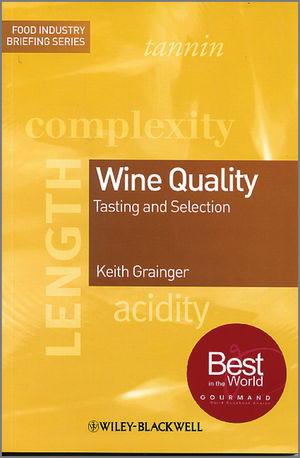Wine Quality: Tasting and SelectionISBN: 978-1-4051-1366-3
Paperback
184 pages
February 2009, Wiley-Blackwell
 This is a Print-on-Demand title. It will be printed specifically to fill your order. Please allow an additional 15-20 days delivery time. The book is not returnable.
|
||||||
Series Editor’s Foreword xi
Preface xiii
Acknowledgements xv
Introduction xvii
Chapter 1 Wine Tasting 1
1.1 Wine tasting & laboratory analysis 1
1.2 What makes a good wine taster? 2
1.3 Where and when to taste – suitable conditions 4
1.4 Appropriate equipment 5
1.4.1 Tasting glasses 6
1.4.2 Water 10
1.4.3 Spittoons 10
1.4.4 Tasting sheets 10
1.4.5 Tasting mats 12
1.5 Tasting order 12
1.6 Temperature of wines for tasting 13
1.7 Tasting for specific purposes 14
1.8 Structured tasting technique 14
1.8.1 Appearance 14
1.8.2 Nose 16
1.8.3 Palate 16
1.8.4 Conclusions 18
1.9 The importance of keeping notes 18
Chapter 2 Appearance 21
2.1 Clarity 21
2.2 Intensity 22
2.3 Colour 24
2.3.1 White wines 25
2.3.2 Ros´e wines 25
2.3.3 Red wines 26
2.3.4 Rim/core 26
2.4 Other observations 28
2.4.1 Bubbles 28
2.4.2 Legs 29
2.4.3 Deposits 33
Chapter 3 Nose 35
3.1 Condition 36
3.2 Intensity 36
3.3 Development 37
3.3.1 Primary 37
3.3.2 Secondary 37
3.3.3 Tertiary 38
3.4 Aroma characteistics 39
Chapter 4 Palate 43
4.1 Sweetness/bitterness/acidity/saltiness/umami 43
4.2 Dryness/sweetness 44
4.3 Acidity 46
4.4 Tannin 47
4.5 Alcohol 49
4.6 Body 50
4.7 Flavour intensity 51
4.8 Flavour characteristics 51
4.9 Other observations 54
4.10 Length 55
Chapter 5 Tasting Conclusions 57
5.1 Quality 57
5.2 Reasons for quality 57
5.3 Readiness for drinking/potential for ageing 59
5.4 Price/value 60
5.5 Identification/true to type? 60
5.6 Grading wine – the award of points 60
5.6.1 Grading on a 20-point scale 61
5.6.2 Grading on a 100-point scale 62
5.7 Blind tasting 63
5.7.1 Why taste blind? 63
5.7.2 Blind or sighted? 64
5.7.3 Tasting for quality 64
5.7.4 Practicalities 64
5.7.5 Examination tastings 65
Chapter 6 Wine Faults and Flaws 67
6.1 Chloroanisoles and bromoanisoles 67
6.2 Fermentation in the bottle and bacterial spoilage 70
6.3 Protein haze 70
6.4 Oxidation 70
6.5 Excessive volatile acidity 71
6.6 Excessive sulfur dioxide 72
6.7 Reductivity 73
6.8 Brettanomyces 74
6.9 Dekkera 75
6.10 Geraniol 75
6.11 Geosmin 75
6.12 Ethyl acetate 76
6.13 Excessive acetaldehyde 76
6.14 Candida acetaldehyde 76
6.15 Smoke taint 77
Chapter 7 Quality – Assurances and Guarantees? 79
7.1 Compliance with ‘Quality Wine’ legislation as an assurance of quality? 79
7.1.1 The European Union and third Countries 79
7.1.2 Table Wine and QWpsr 80
7.1.3 The concept of Appellation Contrˆol´ee 81
7.2 Tasting competitions as an assessment of quality? 84
7.3 Classifications as an official assessment of quality? 86
7.4 ISO 9001 Certification as an assurance of quality? 87
7.5 Established brands as a guarantee of quality? 88
7.6 Price as an indication of quality? 91
Chapter 8 Quality – The Natural Factors and a Sense of Place 93
8.1 Typicity and regionality 94
8.2 The impact of climate upon quality wine production 95
8.3 The role of soils 96
8.4 Terroir 97
8.5 The vintage factor 101
Chapter 9 Constraints upon Quality Wine Production 105
9.1 Financial 105
9.1.1 Financial constraints upon the grower 106
9.1.2 Financial constraints upon the winemaker 107
9.2 Skills and diligence 109
9.3 Legal 110
9.4 Environmental 111
Chapter 10 Production of Quality Wines 113
10.1 Yield 113
10.2 Density of planting 114
10.3 Age of vines 115
10.4 Winter pruning 116
10.5 Stressing the vines 116
10.6 Green harvesting 117
10.7 Harvesting 117
10.7.1 Mechanical harvesting 118
10.7.2 Hand picking 119
10.8 Delivery and processing of fruit 120
10.9 Selection and sorting 120
10.10 Use of pumps/gravity 121
10.11 Control of fermentations 121
10.12 Use of gasses 124
10.13 Barrels 124
10.14 Selection from vats or barrels 125
10.15 Storage 126
Chapter 11 Selection by Buyers 129
11.1 Supermarket dominance 129
11.2 Price point/margin 131
11.3 Selecting for market and customer base 132
11.4 Styles and individuality 132
11.5 Continuity 133
11.6 The place of individual wines in the range 134
11.7 Exclusivity 135
11.8 Specification 135
11.9 Technical analysis 136
Appendix 141
Glossary 145
Bibliography 149
Useful Websites 151
Wine Exhibitions 155
Index 157
A colour plate section appears between pages 28 and 29



